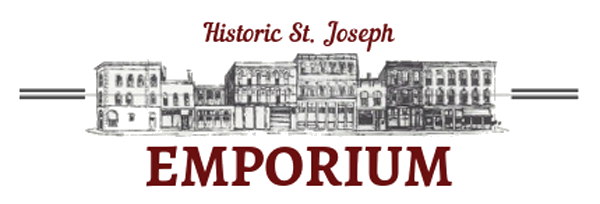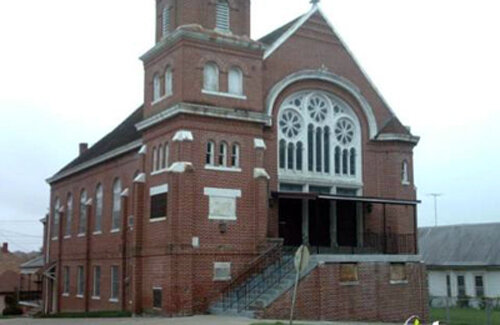Following the Paper Trail: The History of a St. Joseph Congregation and Its Connection to E.J. Eckel
/Blog by Carol Almanza
[Article reprinted with permission from Making Preservation Happen, published by the Heritage Action Campaign]
E.J Eckel – this is the name that appeared at the top of the letterhead my friend, Joan Peterson, and I found while researching our church’s history for its recently celebrated 125th anniversary. It was a receipt dated November 30, 1900 to the first Evangelical Lutheran St. Paul Church for $200.00. Eckel’s fee for the design was three-and-a-half percent of the $10,858 cost of building the church. He was paid in cash and a balance of $179.85 was owed to him. Until finding this receipt, the name of the architect had been lost in the [mist] of time. Although we had known that his firm designed an addition in 1949, the house of worship, located on the southeast corner of 14th and Lafayette Streets, does not appear on any of the lists of Eckel’s work. We had uncovered an important part of St. Joseph’s architectural history. And to understand what led to this event, we need to go back further in time.
In 1852 Lutherans of German descent had tried to start a church, meeting in homes of those dedicated to this cause. They called upon a pastor, Reverend W. Metz, who remained in St. Joseph only two years. After his departure, the believers were served by area pastors, the Rev. W. Zschoche of Atchison, KS., the Rev. M. Meyer of Leavenworth, KS., and Rev. C. Scholz of Coming, MO. encouraged by Pastor Zschoche and the Concordia Seminary faculty in St. Louis, a congregation was again formed and adopted and signed the old constitution on March 27, 1881. The signers were H.W. Kierking, John D.H. Schmidt, H. Meyer, Frederick W. Schmidt, E.H.W. Baden, Fred Kueker, Henry Kueker, and Henry Jaeger. A call was issued to Rev. Moritz Grosse, a recent graduate of Concordia Seminary, in June of 1881. Pastor Grosse accepted and was installed on August 21, 1881. He would shepherd this church for twenty-five years.
A lot at 1019 South Tenth Street was purchased in September of 1881 and on December 17, 1881 the St. Joseph Herald announced “the first and only German Evangelical Luthern [sic] church in this city will be dedicated.” There would be a German sermon in the afternoon and an English one in the evening. The article does not say, however, whether the morning sermon was in German or English. The public was “most respectfully” invited to attend. This house of worship was a frame building. Later, a brick parsonage, which still stands at the back of the lot, was built directly behind the church. What stories could these buildings tell? Sadly, after serving as apartments and for commercial use for many years, the original frame church was razed in the 1950’s.
By 1899, the congregation was growing too large for its small frame church. On February 4, 1900, it resolved to build a new house of worship. The June 29, 1900 edition of the St. Joseph Daily News announced that Superintendent Forgrave had issued a permit (at no charge) to the German Lutherans of St. joseph to build a new church at 14th and Lafayette Streets. Built of pressed brick, with cut stone trimmings, it would be “constructed after the latest architectural models.” However, no mention was made in the article about who would supply those architectural designs. The News was also of the opinion that the church would be “an ornament to that portion of the city as well as a splendidly equipped and beautiful home for the enterprising congregation by which it is erected.” Frank S. Smith was the builder of the church. Along with the Eckel receipt was one from Mr. Smith for $2,458.00, the balance due on the building contract of $10,658. L.F. Gerding, church treasurer, had paid the building costs in full prior to the dedication. Edmond J Eckel’s ecclesial designed church was dedicated in November of 1900.
A third historical find was an agreement signed October 1, 1900, to purchase an organ from George Kilgen & Son of St. Louis, MO for $900.00. Signed by Ida Gerding, President of the Young Ladies Society, and Charles Ehlers, President of the Young Men’s Society, it was to be “complete and ready for use at as early date as possible consisting with first-class work.” the Kilgen organ was fully paid for on December 8, 1900.
After worshipping at 14th and Lafayette for sixty-eight years the growth of the congregation warranted larger facilities. In 1965, members began working toward that goal. Their new and current location would be 4715 Frederick Avenue. Donald R. Hollis, Senior Partner of Hillis & Miller, Architects and Engineers, in his message to the congregation on dedication day stated he felt the new building emphasized contemporary design in church architecture. He felt that his design showed the importance of Christian worship in the location and height of the sanctuary, that the high clerestory windows let the light of the Heavens shine in, and that the tall bell tower crowned with a cross symbolized that it was the House of God. Dedication Day was October 13, 1968. Pastor Robert Kunz, who served the congregation from 1965 to 1986, officiated that October day. In fact, St. Paul Lutheran congregation continues to worship at this location under the guidance of Rev. Terry Weinhold, its pastor since 1986. In 1994, a daycare and multipurpose building were dedicated and in 1995, St. Paul Lutheran School with includes preschool through eight grade, was begun.
The 14th and Lafayette Eckel-designed church continues to serve as a house of worship today for Holsey Chapel. Furthermore, it serves as an architectural monument as well as a testament to the talent of E.J. Eckel.



